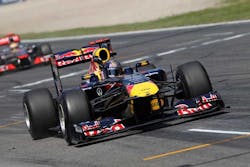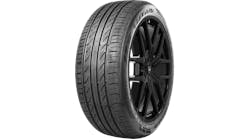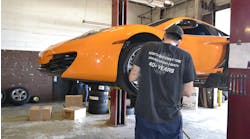Such was their pace, using a combination of Pirelli’s new P Zero Silver hard and P Zero Yellow tires, that with 20 laps still to go they had already lapped everybody up to sixth place with just 1.5 seconds between them. After their final stops, they emerged less than two seconds apart with 16 laps remaining.
The McLaren driver, who like Vettel stopped four times, set fastest lap using the new P Zero Silver hard tire to challenge his Red Bull rival all the way to the flag, ending the 307.104-kilometer race only 0.6s behind. The duo battled with less than a car length between them for the last 10 laps, providing one of the most memorable finishes to a grand prix this season as they carved through the traffic together.
At exactly the same time, there was an equally close fight for the final podium place between their team mates Jenson Button and Mark Webber. Button eventually claimed third thanks to a three-stop race strategy.
Webber started the race from pole using the P Zero Yellow tire, but the new harder P Zero Silver tires were used at the end of the race. The leading runners all had to use the new hard tire at the end of the race, as had been planned.
Lotus Renault’s Nick Heidfeld, who was forced to start from the back of the grid after failing to set a time in qualifying. Heidfeld began the race on the new P Zero Silver tires, switching over to the softer P Zero Yellow tires on lap 21 as part of a three-stop strategy that took him to a points-scoring eighth place from last.
Just behind him, the Sauber team also ran a different strategy to the others, using the hard P Zero Silver tires during their middle stints and finishing the race on the soft tires. This tactic also proved successful, bringing both cars home in the points. Underlining the importance of strategy, this was the first time that the Spanish Grand Prix had not been won from pole position since 2000, when Mika Hakkinen won while Michael Schumacher started from pole.
“It was certainly a dramatic finish to the race, with the battle between Vettel and Hamilton going down to the final lap once again, using our new P Zero Silver tires,” Pirelli’s Motorsport Director Paul Hembery said. “Both of them drove magnificently, treating us all to a fantastic spectacle, and it was thrilling to see such an amazing start to the race from Fernando Alonso and Ferrari as well. Further down the field we also saw several other interesting variants on strategy, notably from Lotus Renault and Sauber. While it was a great race, we’re still not happy with the idea of having four pit stops as three is our target. This was caused by the performance differential between the hard and the soft tires, which prompted the teams to opt for a sprint strategy, as can be seen from the sheer pace of this grand prix.”
Pit stop summary – 2011 Spanish Grand Prix
Vettel: SU SU (9) SN (18) HU (34) HN (48) 4
Hamilton: SU SN (11) SU (23) HU (35) HN (49) 4
Button: SU SN (14) SU (30) HN (48) 3
Webber: SU SU (10) SN (19) HN (29) HN (47) 4
Alonso: SU SU (10) SU (19) HN (29) HN (39) 4
Schumacher: SU SU (10) SN (26) HN (41) 3
Rosberg: SU SU (11) SU (27) HN (42) 3
Heidfeld: HN SN (21) SN (36) SN (50) 3
Perez: SU HN (7) SN (29) SU (47) 3
Kobayashi: SU HN (1) SN (25) SU (44) 3
Petrov: SU SU (11) SU (26) HN (41) 3
Di Resta: SU SN (15) SN (32) HN (51) 3
Sutil: HN SN (13) SN (30) SU (48) 3
Buemi: SU SU (9) SN (25) HN (42) 3
Maldonado: SU SU (8) SU (20) HN (36) HN (53) 4
Alguersuari: SU SN (11) SU (24) HN (36) HN (50) 4
Barrichello: HN SN (11) SN (23) HN (35) SN (54) 4
Trulli: SN SU (15) SU (29) HN (43) 3
Glock: SU SN (16) SU (38) HN (53) 3
D’Ambrosio: SU SN (17) SU (34) HN (49) 3
Karthikeyan: SU SU (14) SU (28) HN (47) 3
Massa: SU SU (11) SU (21) HN (36) 3 (NC)
Kovalainen: SN SU (16) SU (28) HN (41) 3 (NC)
Liuzzi: SU SU (16) 1 (NC)
The first column denotes the tires the driver started the race on.
S = Soft compound
H = Hard compound
N = New compound
U = Used compound
* Drive through
* NC = Not classified
The last column gives the total amount of pit stops.



